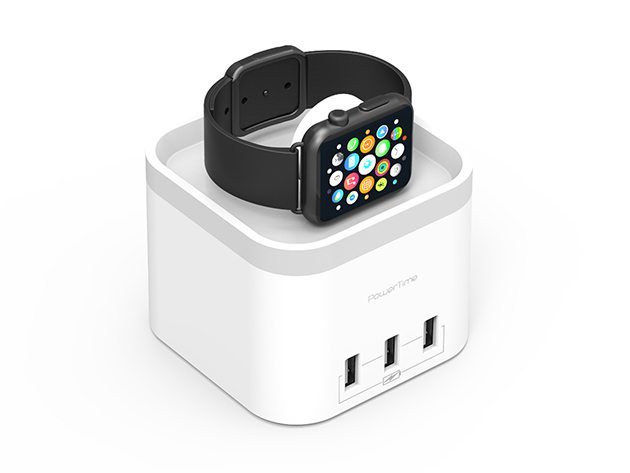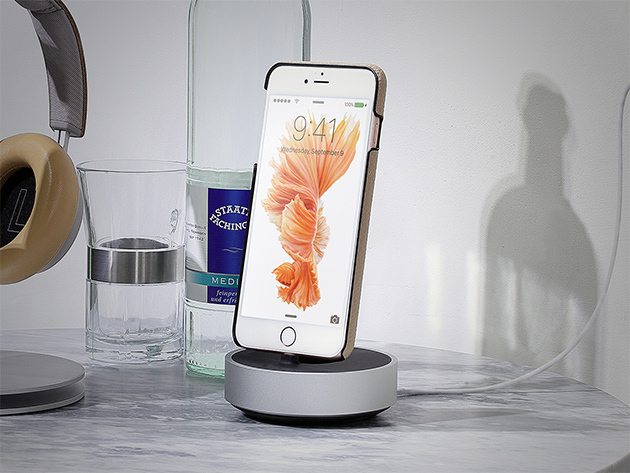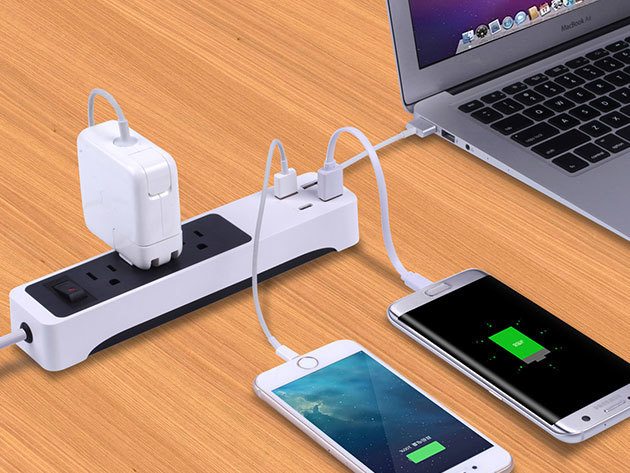4 Common iPhone Charging Myths & How to Get the Most out of Your iPhone’s Battery

Toggle Dark Mode
Do you break out into a cold sweat whenever you notice your iPhone battery dipping below 10%? Whether it was that conference call you needed to make, or the name of that street you were supposed to go left on using turn-by-turn navigation, we need our smartphones for nearly every facet of our daily lives — so much so that when our battery dies, we find ourselves a little bit lost. From organization to communication, our iPhones can sometimes feel less like devices, and more like personal assistants we absolutely need. Seeing as how battery life is so essential, have you ever wondered what an iPhone battery is actually made of, or how you can extend its life? Read on to find out.
How Your iPhone Battery Works
In the spirit of Apple innovation, their batteries don’t come standard. iPhones use lithium-ion batteries, which use high-density energy to recharge. That means more battery life packed into a smaller package, a quicker charge and longer overall battery life.
Apple iPhone batteries use a fast/slow system to charge — they’ll ramp up to 80% quickly, then slow to a trickle for the last 20%. This helps extend the life of the battery and ultimately the life of the iPhone. It also means a faster charge for those times you need to get a reboot and run out the door.
Apple’s lithium-ion batteries also work in charge cycles, so you never need to wait for your battery to lower 100% before recharging. It could take several days for you to use up to 100% of one cycle, which in effect preserves your battery longer.
iPhone batteries are built to hold 80% of the original capacity for a high number of charging cycles — of course, that depends on how you care for your iPhone battery. There are endless theories around how to properly care for you iPhone battery, some of them true, some of them completely false.
Top 4 iPhone Battery Myths, Debunked
4. “Your iPhone should be completely out of battery power before you recharge it.”
Lithium-ion batteries are much smarter than their nickel cadmium and nickel-metal hydride predecessors. Remember when you used to need to wait for batteries in your camera or phone to completely run out? That’s because those older model batteries don’t “count” the charges the way lithium-ion batteries do. But your iPhone battery counts charges in cycles (like we mentioned above) — so it’s essentially counting down the number of full cycle charges it has left in its bank.
It’s actually a less ideal to wait until your iPhone battery is drained to 0%, which places more strain on your battery. Recharging it from zero counts as one of the full charge cycles it has in its repository, so it’ll lower the life of your battery overall.
3. “Leaving your phone to charge overnight (or when it’s already at 100%) will kill your battery.”
Like we said, your iPhone’s battery is smart. So it actually knows to stop charging when it’s reached full capacity. Certainly, with older models of batteries, it would have been possible for the battery to overheat — but iPhones will stop charging when they’ve reached full power, keeping the batteries healthy.
2. “Disabling Bluetooth and Wi-Fi, and closing all my non-active apps are great for battery life.”
Back in the day, Bluetooth and Wi-Fi used to consume a lot of battery — but now, they require so little power that toggling the options on or off doesn’t make a whole lot of difference.
Similarly, closing apps out might actually be doing more damage than just leaving them open as they are, especially if you plan to re-open them soon (think Facebook or Instagram). Although our iPhones are certainly capable of acting like little computers, they don’t operate in the same manner. Specifically, they don’t continuously run applications in the background even when they’re not in use. When we’re not actively using apps on our iPhones, they freeze – and do not use up the battery power required to continuously update.
Keep in mind, it’s still a good idea to see what apps are consuming the most power, and find ways to be smart about the way they refresh or consume data (more on that later).
1. “You can only use Apple chargers with your iPhone.”
All smartphone manufacturers want you to use their official charger with your device — that’s because poorly-made, counterfeit charges can damage your battery life and ruin your phone. But that doesn’t mean that you can’t use a high quality, third-party charger on your phone — in fact, many “non-official” brands can offer the same quality for less money.You just need to be selective and wary about which options you choose — do your research! Look for MFi certification, which signifies that the accessory is fully Apple-approved. The MFi program means the third-party manufacturer passes Apple’s strict quality control protocols, and their hardware won’t damage your Apple devices.
5 Tips to Improve iPhone Battery Life
1. Turn off Your iPhone
Simple, intuitive and simply not done enough. Like everything else in life, your phone needs a break too. Leaving your phone up and running 24/7 puts unnecessary stress on the battery. Unless you’re a doctor on call or in another profession that requires you to be easily reached at all hours, you don’t need to leave your phone on all night or during moments in the day where you know you won’t be using it.
2. Turn on Auto-Brightness
Your iPhone’s screen consumes more energy than even your apps do — in order to conserve battery life, reduce your screen brightness. Enable auto-brightness in your settings, which can help cut down on battery consumption by at least 50%. Auto-brightness immediately adjusts your phone’s brightness settings based on ambient light it picks up in your surroundings.
3. Avoid extreme temperatures
For all you snow or beach bunnies, you’re killing your phone’s battery life if you’re taking it with you to the powder or sand. Your iPhone battery is most comfortable between 62-72 degrees — anything too much lower or higher than that, and you’re damaging your battery capacity. Better to just leave it indoors (and maybe even turn it off when you do).
4. Update iOS
Yes, it can be a pain, but it’s totally necessary for your battery’s health. System improvements, including bug fixes, mean that your phone runs better, and your battery strains less trying to work around inefficiencies.
5. Check Your Battery Usage List
Common sense will prevail over all else, at the end of the day. While toggling around with your Wi-Fi and Bluetooth settings might not be particularly helpful, it is nice to see what apps are consuming the most energy, and why. You can start to be discerning and selective about what apps you choose to consume battery life.
If you’re noticing a lot of apps are using energy in the background, disable “Background App Refresh”. That might mean an email app checking for messages even while you’re asleep, or a fitness app that’s always hunting down your location.
On a similar note, cut out any unnecessary GPS/location tracking services — they consume a ton of energy, especially when not in use. You can view those in your “Privacy” settings, underneath “Location Services”.
4 Unique iPhone Charging Solutions
You can apply those tips and tricks to keep your iPhone battery healthy, but at the end of the day, your phone will still need to be charged. We’ve done the research for you and found reliable, powerful charging solutions and accessories that won’t damage your iPhone.
1. 10-Ft MFi-Certified Lightning Cable: 3-Pack
 These extra-long Lightning cables mean you won’t need to scoot around the room looking for an outlet that’s close enough, or hop out of bed unnecessarily. Since they come in a 3-pack, you can keep one in your car, office or home for an easy charge, every time. They’re also MFi-certified, so your device will stay safe as it’s charging.
These extra-long Lightning cables mean you won’t need to scoot around the room looking for an outlet that’s close enough, or hop out of bed unnecessarily. Since they come in a 3-pack, you can keep one in your car, office or home for an easy charge, every time. They’re also MFi-certified, so your device will stay safe as it’s charging.
Get It Here: Get the 10-Ft MFi-Certified Lightning Cable: 3-Pack for $29.99, or 76% off.
2. PowerTime Apple Watch Charging Dock with 3 USB Ports
 Reduce cable clutter with this compact charging dock for your Apple Watch. Not only does it allow you to charge your watch without an additional cord in the space, the extra three USB hubs mean you can use this as your central charging station.
Reduce cable clutter with this compact charging dock for your Apple Watch. Not only does it allow you to charge your watch without an additional cord in the space, the extra three USB hubs mean you can use this as your central charging station.
Get It Here: Get the PowerTime Apple Watch Charging Dock with 3 USB Ports for $44.99, or 8% off the retail price of $49.
3. Kinkoo 3-Outlet Surge Protecting Smart Power Strip
Another space-saver, especially if you’re working in a tighter office space or coffee shop: this power strip allows you to charge 3 appliances and 4 devices simultaneously (no need to worry about short circuiting). Pack it up and take it with you on the road.
Get It Here: Get the Kinkoo 3-Outlet Surge Protecting Smart Power Strip for $24.99, reduced from $35 for 28% savings.
4. HoverDock for iPhone

Sleek and simple, the HoverDock has an upright stance that allows you to see your phone’s full display, even as you charge it. The design keeps cords neatly out of the way and even has a swivel base perfect for FaceTime or video conference calls.
Get It Here: Get the HoverDock for iPhone for $32.99.







